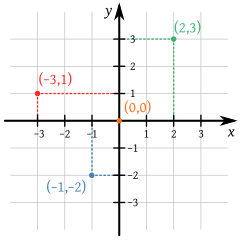Cartesian product
In mathematics, the Cartesian product of two sets is an operation, which results in another set, whose elements are all the ordered pairs that can be formed such that the first element of the ordered pair belongs to the set. first set and the second element belongs to the second set.
The Cartesian product is named after René Descartes, whose formulation of analytic geometry gave rise to this concept.
Example
For example, given the sets:
- A={1,2,3,4!{displaystyle A={1,2,3,4}
and
- B={a,b!{displaystyle B={a,b}
your cartesian product of A times B is:
- b(1,b)(2,b)(3,b)(4,b)a(1,a)(2,a)(3,a)(4,a)A× × B1234{displaystyle {begin{array}{rącccccc}b hypo(1,b)}{(2,b) hypo(2,b)}{(3,b)}{,b)}{b)}{b}{b}{b) age(3,b) alien(3,b) age(3,b) age(4,b)}{b) age(4, b\\times b\\pos(4,b) age(4, b}{\\pos(4}{pos(4}{pos(4}{pos(4b)}{\pos(4}{\pos(4}{\b) ages b}{\\pos(4}{b) ages b}{pos(4}{b)}{\pos(4}{\\pos(4}{b)}{array}{b)}{array}{b)}{array}{\b)}{\b)}{
what is rendered:
- A× × B={(1,a),(1,b),(2,a),(2,b),(3,a),(3,b),(4,a),(4,b)!{displaystyle Atimes B={(1,a),(1,b),(2,a),(2,b),(3,a),(3,b),(4,a),(4,b)}
and the Cartesian product of B times A is:
- 4(a,4)(b,4)3(a,3)(b,3)2(a,2)(b,2)1(a,1)(b,1)B× × Aab{displaystyle {begin{array}{rącc}4 nightmare(a,4)}{(b,4)3}{3}{3}{a,32}{2}{b,}{1}{1}{1}{1}{b,}{3}{3}{b,}{b,}}{b,}}{b,}}{b,}{b
what is rendered:
- B× × A={(a,1),(a,2),(a,3),(a,4),(b,1),(b,2),(b,3),(b,4)!{displaystyle Btimes A={(a,1),(a,2),(a,3),(a,4),(b,1),(b,2),(b,3),(b,4)}}
See that:
- (1,a)I was. I was. (a,1){displaystyle (1,a)neq (a,1)}
Since they are ordered pairs.
Definition
Is a collection of two distinguished objects as first and second, and is denoted as (a, b), where a is the "first element" and b the “second element”. Given two sets A and B, their Cartesian product is the set of all ordered pairs that can be formed with these two sets:
|
The Cartesian square of a set can then be defined as A2 = A × A.
Examples
- Integer numbers
Let also be the set of all integers Z = {..., −2, −1, 0, +1, +2,...}. The Cartesian product of Z with itself is Z2 = Z × Z = { (0,0), (0, +1), (0, −1), (0, +2),..., (+1, 0),... (−1, 0),... }, that is, the set of ordered pairs whose components are integers. To represent the integers, the number line is used, and to represent the set Z2, a Cartesian plane is used (in the image).
- Painting and brushes
Let the sets be T of paint tubes, and P of brushes:
The Cartesian product of these two sets, T × P, contains all possible pairings of paint tubes and brushes. Similar to the case of a Cartesian plane in the previous example, this set can be represented by a table:
Properties
The empty set acts as the zero of the Cartesian product, since it does not have elements to build ordered pairs:
|
The Cartesian product of two sets is not commutative in general, except in very special cases. The same goes for the associative property.
|
Since the cartesian product can be represented as a table or a cartesian plane, it is easy to see that the product set is the product of the cardinals of each factor:
|
In set theory, the previous formula of the cardinal of the Cartesian product as the product of the cardinals of each factor, still holds true using infinite cardinals.
Generalizations
Finite case
Given a finite number of sets A1, A 2,..., An, its Cartesian product is defined as the set n-tuples whose first element is in A1, whose second element is in A2, etc.
|
We can then define Cartesian powers of order higher than 2, as A3 = A × A × A, etc. Depending on the definition of n-tuple that is adopted, this generalization can be built from the basic definition as:
- A1× × ...... × × An=A1× × (A2× × (...... × × An)...... ){displaystyle A_{1}times ldots times A_{n}=A_{1}times (A_{2}times (ldots times A_{n})ldots}}}
or similar constructs.
Infinite case
In the case of an arbitrary (possibly infinite) family of sets, the way to define the Cartesian product is to change the tuple concept to a more comfortable one. If the family is indexed, an application traversing the index set is the object that distinguishes who is the "kth entry":
|
where ∪F denotes the union of all Ai. Given a j ∈ I, the projection onto the j coordinate is the map:
- π π j: i한 한 IAi→ → Aj,π π j(f)=f(j){displaystyle pi _{j}:prod _{iin I}A_{i}to A_{j} pi _{j}(f)=f(j)}
In the case of a finite family of sets {A1,..., A n} indexed by the set In = {1,..., n}, depending on the definition of n-tuple adopted, or the applications f: In → ∪i Ai of the previous definition are precisely n-tuples, or there is a natural identification between both objects; Therefore, the previous definition can be considered as the most general.
Unlike the finite case, however, the existence of such applications is not justified by the most basic hypotheses of set theory. These maps are in fact choice functions whose existence can only be shown in general if the axiom of choice is assumed. In fact, the existence of choice functions (when all members of F are non-empty) is equivalent to such an axiom.
Contenido relacionado
Topological space
Complementary angles
Infinite







































